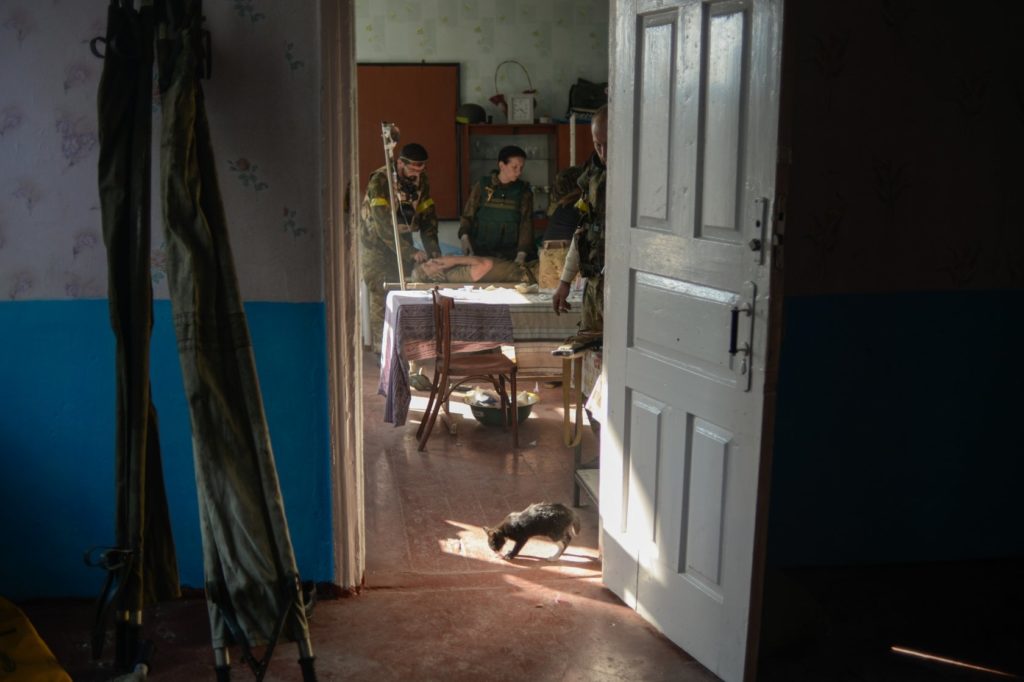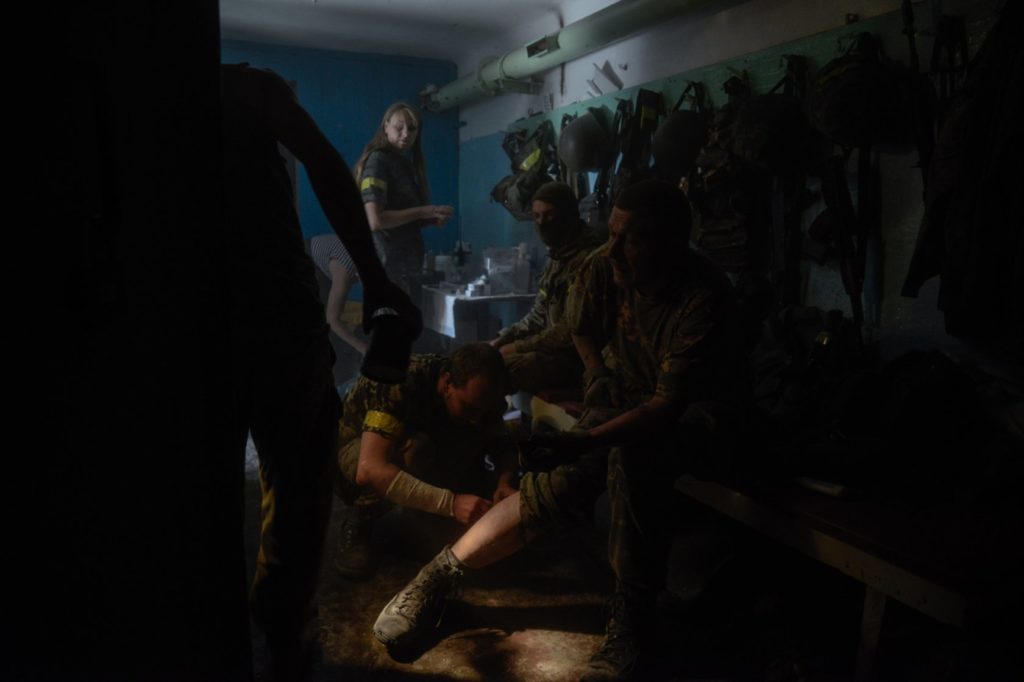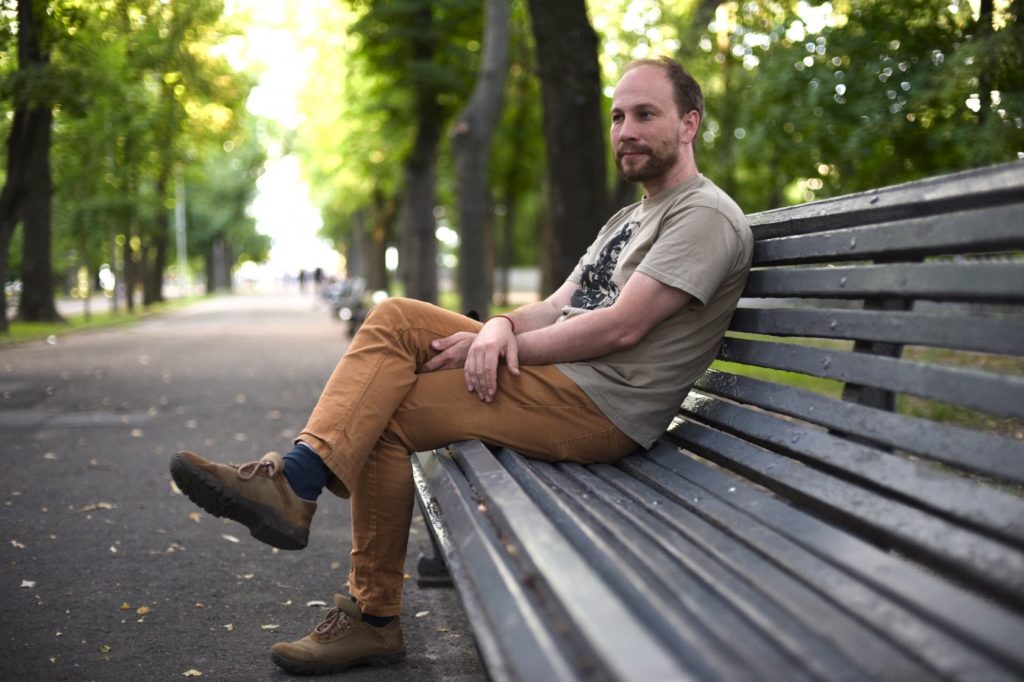AFTERILOVAISK. “Yar”
And what is the war, I think, no one knows exactly. Until he sees it.
Photo: Markiian Lyseiko
Serhii Mishchenko, nickname, “Yar” – shooter-paramedic. The first platoon of the first assault company of the battalion “Donbass”, Kyiv.
Before the war, I used to play airsoft, but it was just a hobby, a pastime. And what is the war, I think, no one knows exactly. Until he sees it. Even the military men, who have served during peacetime, hardly knew what war was. But I considered it my duty to be there. Honestly, I thought that everything would end up quickly. In Ilovaisk, I regretted that on September 1st, I would not be able to take my child to school. Everything dragged on more than I expected.
I was on Maidan, I have imbued with it, later I went through the course of paramedics training. Just on February 18-20 (the escalation days on Maidan), my wife was operated on, and after the operation, she said: “In general, it’s good that I’ve got the tumor and that the operation was done so quickly, otherwise you would be on Maidan these days”. I had a feeling of unfulfilled duty and knowledge of paramedics, so I got into the battalion “Donbass”.

I got to Ilovaisk with the “Donbass” battalion and went out of there on the 29th using so-called “green corridor.” We have arranged a “field hospital” in Krasnoselsky village. When our troops surrendered, I went with all the wounded in KAMAZ of the Russian army, we were taken to the place of disposition of the captives.
On August 19th, 2014, There were a lot of wounded soldiers, the doctors left Ilovaisk for evacuation with them. However, I was a simple shooter-paramedic of the assault company, so I stayed. It was necessary to organize a hospital. Here we have gathered – Me, “Cat”, “Breeze” – and made the hospital almost out of nothing, from the contents of the pouch of fighters. But on August 23, we had even run out of bandages. The girls were already going to look for sheets from the houses, but on these days a column of medicines came in. The Israeli bandages, probably for a few thousand dollars, were fitted to us by the Dnieper-1 battalion, they helped us very much later in Krasnoselsky. Also came two paramedics. There was a lack of organized evacuation of the wounded and knowledge: we knew what to do with the wounded on the first day, but what to do next when the wound is suppurating, for example? We had only theoretical ideas about this.
“Murka” with “Mary” became our angels. Two volunteers who came to Ilovaisk said: “Oh, it’s hot here. We will not leave. ” According to the documents, they were not registered with us. “Mary” – in my opinion, a medical lab assistant, and “Murka” – an anesthesiologist. Their knowledge helped us a lot. In Ilovaisk, we have lost people, but these were losses that could hardly be stopped. In the Mnogopolye on the territory of the school, there was a good Ukrainian Armed Forces medical surgeon, they took out the wounded, and he had a lot of work to do.

On August 29, when we started to leave the Mnogopolye, the second or third car was the KAMAZ with the wounded under a big white flag with a red cross. In KAMAZ there were only the wounded. The entire body was literally laid by the wounded, but it was one of the first to be hit. Probably, they firstly destroyed the heavy equipment, then, if ammunition was left, they hunted for smaller ones.
We were saved by the fact that we were traveling in ordinary cars.
We jumped into Krasnoselskoye and occupied four houses on the outskirts. A hospital was made in one house. Another was organized in the cellar in the neighboring house, where “Cat” and “Alina” worked. Me, “Mary” and “Therapist” worked with the heaviest.
We had 3 dead from wounds, which were unrealistic to save, and 10 seriously wounded.
The “Cats” at one point gave wounded to the Russians. Among them, there was “Gor” and “Vinnitsa”, who lost his leg. I am convinced, that it was only because he was not given proper medical treatment in captivity.
If there is an escalation, we, of course, are already. I cannot say that my backpack is fully assembled – I dismantled it. But the first-aid kit lies.

We spent the whole night in Krasnoselsky. Then there was the captivity.
We, the doctors, were offered: “You are free, we do not fight with doctors”. I chose to stay with the wounded. “Therapist”, on the contrary, stayed in Krasnoselsky, changed into civilian. The family-friends had to come for him, but in the end, he disappeared. The terrorist came. They beat him up, threw him into the car with the words “now we’ll see what kind of doctor you are” and we did not see him again.
We went into a cornfield, the wounded were not taken out of KAMAZ, they spent the night there. It was very cold, even worse for the wounded – they lacked blood, we wrapped them up as best as we could. In the morning “Est” died.
I took him to the Russians, the Russian officer pointed to a place where I saw three other people who had died from wounds. Not far in the field there were located 300-400 Armed Forces troops. I have a little mind blow: I went to the Russian officers, threatened with The Hague.
I know that they were Russians – by the uniform, military rations and by the technique, the manner of fighting. Yes, they did not hide. In addition, I communicated with the prisoners who were taken by ours in Krasnoselsky. They mentioned the names of their parts. In addition, I went “to the other side” as a paramedic, talked a lot with both soldiers and officers. They did not have a doctor of their own, and for my “medical services,” they gave one of our wounded, “Poltava” – from Poltava, the local grandmother took care of him. He was very bad, but he survived, well done.

Иловайск, 27 августа 2014. Фото: Макс Левин
I went to the Russians to asks for water for the wounded and for us. We were given 4 Russian military rations – only for the wounded. And we still took care of the seriously injured Armed Forces officers, about 10 people. Then they gave out more rations, but with a calculation of one ration for 20-30 people. They said that they came without a convoy and that they do not have enough for themselves
Then they lined us up.
An officer approached me and asked the exact number of wounded. I immediately said – 45. Because I figured that around 45 people would fit into KAMAZ. They asked whether this number was accurate. I said:
– Yes, I know for sure.
“Well, go and count it.”
In fact, 15 people were seriously injured. I went to “Yatsek”, “Grandfather” was also with him and I said that, firstly, I need security. Secondly – the personnel to carry people: “We need some of our boys, we will now make them wounded.” So, they took away all the wounded. And a few people, who agreed to go to the exit, have been wrapped in bandages. Thus, 35 people have left, four girls went separately. It turned out that all the wounded were jammed in KAMAZ. They lined up everyone on the field and said: “Donbass” – to the left, Armed Forces – to the right.
I think the Russians did not go any further just because they saw the force because they were rebuffed.
Well, our hussars: you could take off your jacket, the chevrons were not at all there, but we decided together, then together. Armed Forces troops were driven along the road, and we closed KAMAZ from behind, followed by a BMD, on which the girls were put. We were taken to the village. We drove 10-12 kilometers, and during this time I saw a lot of machines, loads of them. More than eight NON, self-propelled mortars, I do not know whether they are in service with the ZSU. I also saw about ten BTRs, they were guarded.
All fields were dug up, everywhere – “secrets”. It was clear that the trench, and their guys with machine guns.
We were taken to a village. We stood in anticipation of the column of the Red Cross. There were disguised drivers, just a couple of doctors – all the other guys for guarding. We were loaded into a convoy, I sat down with the heaviest in the car – there were two of them. We were taken to Rozovka, Zaporozhye region, where the hospital was located. I was transferred to the “turntable” on the Dnieper on September 1st. I found my own there, took them out, found out where one of the wounded was lying, to what direction the hospital was being sent.

After Ilovaisk, I stayed in the battalion. My function was to provide medical assistance in a training camp in the Dnieper with a new replenishment. We also dealt with the exchange of prisoners. One exchange turned out very successful – two on five: one was, probably, very important.
But in fact, after Ilovaisk, I no longer fought.
Exchanges have become for me a kind of rehabilitation. When I got to the peaceful Dnieper in September, I had a shock. In Kiev, he could not go to the subway, go to the crowd. When my wife saw me off to the Dnieper (in 2014), she said at the station: “Look, you do not smile so happy, I’ll see you off to the war all the same.”
There were rehabilitation courses. They are all conditional, of course, work. I think that another veteran should work together with a psychologist on the principle “to his own selves”. When a young girl psychologist asks a fighter with an amputation: “What’s bothering you?”. What can he answer her?
My son says that I have become more rigid, but I do not think that this can be corrected.
Last year, in August, I experienced an aggravation – the wing was concrete. I collected photos of the dead guys and made a video for music, it helped me, something like art therapy. But this year I attend a school of journalism for veterans. Previously, like: I would go and smoke and smoke, but now I am grinding all these stories in myself, put them on paper, I’ve become more open and it’s easier for me to talk about it. It helps me, like therapy.

If I used to think about the development of my business, now it has come to the fore. Everything looks secondary, it seems not so important, there was a reassessment of values.
If there is an escalation, we, of course, are already. I think the Russians did not go any further just because they saw the force because they were rebuffed. I cannot say that my backpack is fully assembled – I dismantled it. But the first-aid kit lies. We will not let them in here, but it’s somehow hard to participate in the positional war, I guess. I do not see myself in this because now the army has become more structured. I’m not an army man, for me that time (2014), frankly, the time of the Makhnovshchina – it’s mine.
Now I am engaged in marketing and advertising, as before the war. But before that, I had my own printing house, and now I work for hire. In principle, I’m completely satisfied with this, because now I do not see my own business, there are too many unhealthy running around.

